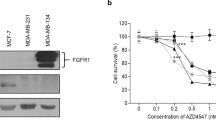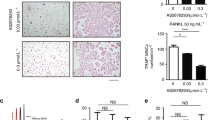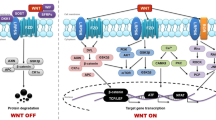Abstract
Objective
Bone, besides lung and liver, is one of the most preferential metastatic target sites for breast cancers. Although the precise molecular mechanisms underlying this preference need to be elucidated, it appears that bone microenvironments possess unique biological features that enable circulating cancer cells to home, survive and proliferate, and destroy bone. The majority of human breast cancers and in addition most breast cancer cell lines express GnRH receptors. Their proliferation is time- and dose-dependently reduced by GnRH-I and GnRH-II agonists by counteracting of the mitogenic signal transduction.
Methods
We have established a coculture system of different breast cancer cell lines stable transfected with red fluorescence (DS-Red) and human primary osteoblasts (hOB) or MG63 human osteosarcoma cells to analyze tumor cell invasion to bone.
Results
We could show that breast cancer cell invasion was increased when cocultured with hOB or MG63. Treatment with GnRH-I and GnRH-II analogs reduced the ability to invade a reconstituted basement membrane (Matrigel) and to migrate in response to the cellular stimulus. Searching for the molecular mechanisms we found that GnRH treatment reduces expression of the osteoblast derived chemokine SDF-1 by hOB or MG63 cells cocultured with breast cancer cells.
Conclusion
These data represent the first report that the activation of tumor GnRH receptors reduces the metastatic potential of breast cancer cells. The crosstalk between metastatic breast cancer cells and bone is critical to the development and progression of bone metastases. Disruption of this interaction will allow us to design mechanism-based effective and specific therapeutic interventions for bone metastases.
Similar content being viewed by others
References
Ferlay J, Bray F, Pisani P, Parkin DM (2001) GLOBOCAN 2000: cancer incidence, mortality and prevalence worldwide, version 1.0. IARC CancerBase No. 5. IARC Press, Lyon
Chirgwin JM, Guise TA (2003) Molecular mechanisms of cancer metastases to bone. Curr Opin Orthop 14:317–321
Guise TA, Kozlow WM, Heras-Herzig A, Padalecki SS, Yin JJ, Chirgwin JM (2005) Molecular mechanisms of breast cancer metastases to bone. Clin Breast Cancer Suppl 2:46–53
Fekete M, Wittliff JL, Schally AV (1989) Characteristics and distribution of receptors for [D-TRP6]-luteinizing hormone-releasing hormone, somatostatin, epidermal growth factor, and sex steroids in 500 biopsy samples of human breast cancer. J Clin Lab Anal 3:137–147
Baumann KH, Kiesel L, Kaufmann M, Bastert G, Runnebaum B (1993) Characterization of binding sites for a GnRH-agonist (buserelin) in human breast cancer biopsies and their distribution in relation to tumor parameters. Breast Cancer Res Treat 25:37–46
Moriya T, Suzuki T, Pilichowska M, Ariga N, Kimura N, Ouchi N, Nagura H, Sasano H (2001) Immunohistochemical expression of gonadotropin releasing hormone receptor in human breast carcinoma. Pathol Int 51:333–337
Mangia A, Tommasi S, Reshkin SJ, Simone G, Stea B, Schittulli␣F, Paradiso A (2002) Gonadotropin releasing hormone receptor expression in primary breast cancer:comparison of immunohistochemical, radioligand and Western blot analyses. Oncol Rep 6:1127–1132
Miller WR, Scott WN, Morris R, Fraser HM, Sharpe RM (1985) Growth of human breast cancer cells inhibited by a luteinizing hormone-releasing hormone agonist. Nature 313:231–233
Blankenstein MA, Henkelmann MS, Klijn JG (1985) Direct inhibitory effect of a luteinizing hormone-releasing hormone agonist on MCF-7 human breast cancer cells. Eur J Cancer Clin Oncol 21:1493–1499
Foekens JA, Henkelmann MS, Fukkink JF, Blankenstein MA, Klijn JG (1986) Combined effects of buserilin, estradiol and tamoxifen on the growth of MCF-7 human breast cancer cells in vitro. Biochem Biophys Res Commun 140:550–556
Eidne KA, Flanagan CA, Harris NS, Millar RP (1987) Gonadotropin releasing hormone (GnRH)-binding sites in human breast cancer cell lines and inhibitory effects of GnRH-agonists. J Clin Endocrinol Metab 64:425–432
Neri C, Berthois Y, Schatz B, Drieu K, Martin PM (1990) Compared effects of GnRH analogs and 4-hydroxytamoxifen on growth and steroid receptors in antiestrogen sensitive and resistant MCF-7 breast cancer sublines. Breast Cancer Res Treat 15:85–93
Scott WN, Mullen P, Miller WR (1991) Factors influencing the response of MCF-7 cells to an agonist of luteinising hormone-releasing hormone. Eur J Cancer 27:1458–1461
Hershkovitz E, Marbach M, Bosin E, Levy J, Roberts Jr CT, LeRoith D, Schally AV, Sharoni Y (1993) Luteinizing hormone-releasing hormone antagonists interfere with autocrine and paracrine growth stimulation of MCF-7 mammary cancer cells by insulin-like growth factors. J Clin Endocrinol Metab 77:963–968
Szepeshazy K, Milovanovic S, Lapis K, Groot K, Schally AV (1992) Growth inhibition of estrogen independent MXT mouse mammary carcinomas in mice treated with an agonist or antagonist of LH-RH, an analog of somatostatin, or a combination. Breast Cancer Res Treat 21:181–192
Emons G, Müller V, Ortmann O, Grossmann G, Trautner U, v. Stuckrad B, Schulz KD, Schally AV (1996) Luteinizing hormone-releasing hormone agonist triptorelin antagonizes signal transduction and mitogenic activity of epidermal growth factor in human ovarian and endometrial cancer cell lines. Int J Oncol 9:1129–1137
Gründker C, Völker P, Emons G (2001) Antiproliferative signaling of luteinizing hormone-releasing hormone in human endometrial and ovarian cancer cells through G protein αi-mediated activation of phosphotyrosine phosphatase. Endocrinology 142:2369–2380
Gründker C, Günthert AR, Westphalen S, Emons G (2002) Biology of GnRH systems in human gynecological cancers. Eur J␣Endocrinol 146:1–14
Gründker C, Günthert AR, Hellriegel M, Emons G (2004) Gonadotropin-releasing hormone (GnRH) agonist triptorelin inhibits estradiol-induced serum response element (SRE) activation and c-fos expression in human endometrial, ovarian and breast cancer cells. Eur J Endocrinol 151:619–628
Günthert AR, Gründker C, Hollmann K, Emons G (2002) Luteinizing hormone-releasing hormone induces JunD-DNA binding and extends cell cycle in human ovarian cancer cells. Biochem Biophys Res Commun 294:11–15
Günthert AR, Gründker C, Olota A, Läsche J, Eicke N, Emons G (2005) Analogs of gonadotropin-releasing hormone I (GnRH-I) and GnRH-II inhibit EGF-induced signal transduction and resensitize resistant human breast cancer cells to 4OH-tamoxifen. Eur J Endocrinol 153:613–625
Günthert AR, Gründker C, Bongertz T, Nagy A, Schally AV, Emons G (2004) Induction of apoptosis by AN-152, a cytotoxic analog of luteinizing hormone-releasing hormone (LHRH), in LHRH-R positive human breast cancer cells is independent of multi drug resistance-1 (MDR-1) system. Breast Cancer Res Treat 87:255–264
Viereck V, Gründker C, Blaschke S, Siggelkow H, Emons G, Hofbauer LC (2002) Phytoestrogen genistein stimulates the production of osteoprotegerin by human trabecular osteoblasts. J␣Cell Biochem 84:725–735
Siggelkow H, Rebenstorff K, Kurre W, Niedhart C, Engel I, Schulz H, Atkinson MJ, Hüfner M (1999) Developmental of the osteoblast phenotype in primary human osteoblasts in culture:Comparison with rat calvarial cells in osteoblast differentiation. J Cell Biochem 75:22–35
Billiau A, Cassiman JJ, Willems D, Verhelst M, Heremans H (1975) In vitro cultivation of human tumor tissues. Oncology 31:257–272
Gründker C, Günthert AR, Millar RP, Emons G (2002) Expression of gonadotropin-releasing hormone II (GnRH-II) receptor in human endometrial and ovarian cancer cells and effects of GnRH-II on tumor cell proliferation. J Clin Endocrinol Metab 87:1427–1430
Moretti RM, Montagnani Marelli M, van Groeningnen JC, Limonta P (2002) Locally expressed LHRH receptors mediate the oncostatic and antimetastatic activity of LHRH agonists on melanoma cells. J Clin Endocrinol Metab 87:3791–3797
Gnanapragasam VJ, Darby S, Khan MM, Lock WG, Robson CN, Leung HY (2005) Evidence that prostate gonadotropin-releasing hormone receptors mediate an anti-tumourigenic response to analogue therapy in hormone refractory prostate camcer. J Pathol 206:205–213
Yates C, Wells A, Turner T (2005) Luteinising hormone-releasing hormone analogue reverses the cell adhesion profile of EGFR overexpressing DU-145 human prostate carcinoma subline. Br J␣Cancer 92:366–375
Spencer KS, Graus-Porta D, Leng J, Hynes NE, Klemke RL (2000) ErbB2 is necessary for induction of carcinoma cell invasion by ErbB family receptor tyrosine kinases. J Cell Biol 148:385–397
Price JT, Tiganis T, Agarwal A, Djakiew D, Thompson EW (1999) Epidermal growth factor promotes MDA-MB-231 breast cancer cell migration through a phosphatidylinositol 3′-kinase and phospholipase C-dependent mechanism. Cancer Res 59:5475–5478
Hynes NE (2000) Tyrosine kinase signalling in breast cancer. Breast Cancer Res 2:154–157
Shirozu M, Nakano T, Inazawa J, Tashiro K, Tada H, Shinohara T, Honjo T (1995) Structure and chromosomal localization of the human stromal cell-derived factor 1 (SDF1) gene. Genomics 28:495–500
Nagasawa UT, Tachibana UK, Kishimoto T (1998) A novel CXC chemokine PBSF/SDF-1 and its receptor CXCR4:their functions in development, hematopoiesis and HIV infection. Semi Immunol 10:179–185
Müller A, Homey B, Soto H, Ge N, Catron D, Buchanan ME, McClanahan T, Murphy E, Yuan W, Wagner SN, Barrera JL, Mohar A, Verastegui E, Zlotnik A (2001) Involvement of chemokine receptors in breast cancer metastasis. Nature 410:50–56
Yun HJ, Jo DY (2003) Production of stromal cell-derived factor-1 (SDF-1) and expression of CXCR4 in human bone marrow endothelial cells. J Korean Med Sci 18:679–685
Aust G, Steinert M, Kiessling S, Kamprad M, Simchen C (2001) Reduced expression of stromal-derived factor 1 in autonomous thyroid adenomas and its regulation in thyroid-derived cells. J␣Clin Endocrinol Metab 86:3368–3376
Kang H, Watkins G, Parr C, Douglas-Jones A, Mansel RE, Jiang WG (2005) Stromal cell derived factor-1:its influence on invasiveness and migration of breast cancer cells in vitro, and its association with prognosis and survival in human breast cancer. Breast Cancer Res 7:R402–410
Ross DT, Scherf U, Eisen MB, Perou CM, Rees C, Spellman P, Iyer V, Jeffrey SS, Van de Rijn M, Waltham M, Pergamenschikov A, Lee JC, Lashkari D, Shalon D, Myers TG, Weinstein JN, Botstein D, Brown PO (2000) Systematic variation in gene expression patterns in human cancer cell lines. Nature Gen 24:227–235
Ellison G, Klinowska T, Westwood RFR, Docter E, French T, Cox JC (2002) Further evidence to support the melanocytic origin of MDA-MB-435. J Clin Pathol Mol Pathol 55:294–299
Sellappan S, Grijalva R, Zhou X, Yang W, Bar Eli M, Mills GB, Yu D (2004) Lineage infidelity of MDA-MB-435 cells:expression of melanocyte proteins in a breast cancer cell line. Cancer Res 64:3479–3485
Acknowledgements
We are grateful to Zentaris (Frankfurt, Germany) for supplying the GnRH-I antagonist Cetrorelix and to Ferring Pharmaceuticals (Copenhagen, Denmark) for the gift of the GnRH-I agonist Triptorelin. This work was supported by the Deutsche Krebshilfe, Dr. Mildred Scheel Stiftung.
Author information
Authors and Affiliations
Corresponding author
Rights and permissions
About this article
Cite this article
von Alten, J., Fister, S., Schulz, H. et al. GnRH analogs reduce invasiveness of human breast cancer cells. Breast Cancer Res Treat 100, 13–21 (2006). https://doi.org/10.1007/s10549-006-9222-z
Received:
Accepted:
Published:
Issue Date:
DOI: https://doi.org/10.1007/s10549-006-9222-z




